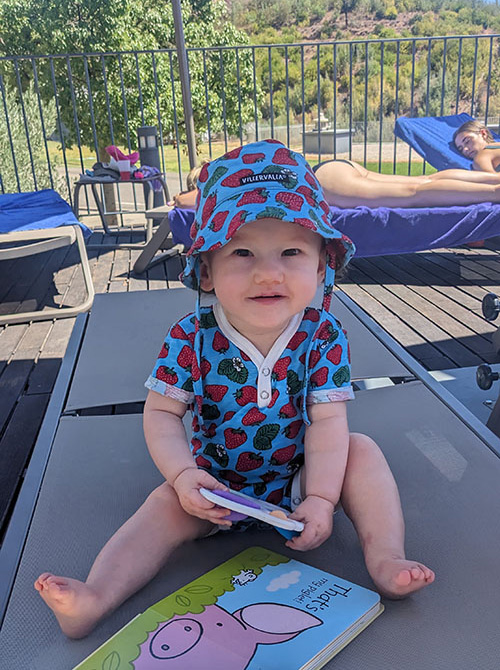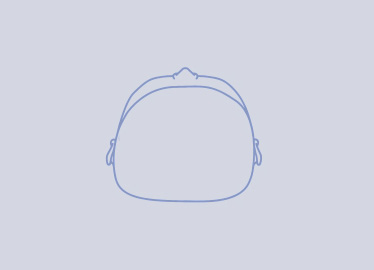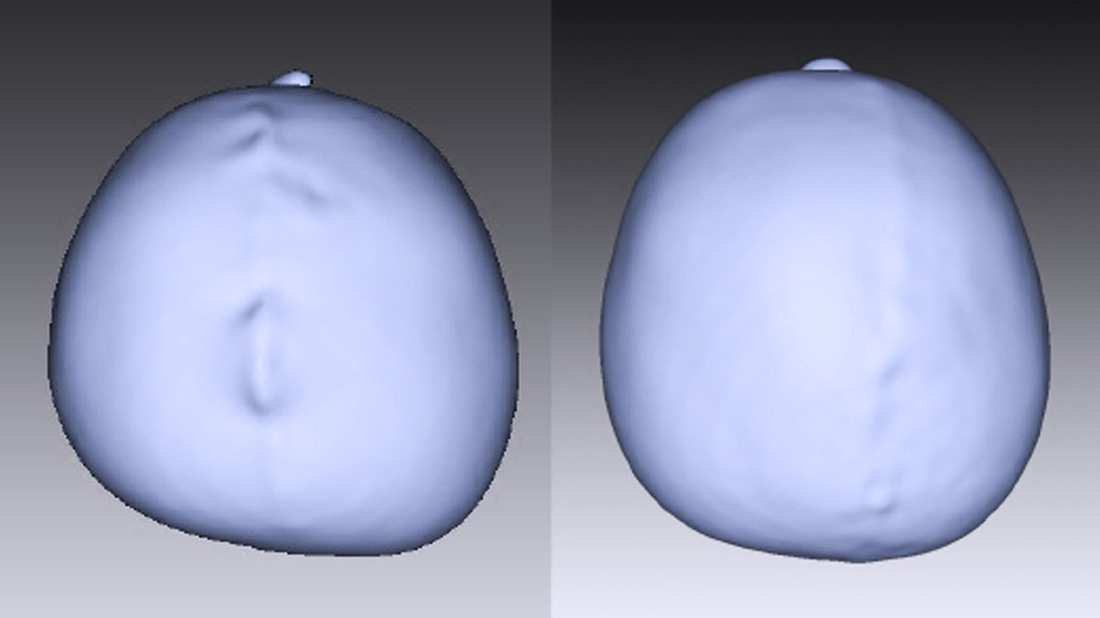
Ada after her brachycephaly treatment
31 August 2023
Ada’s severe brachycephaly has been resolved thanks to LOC’s cranial remoulding helmet therapy.
Ada was a premature baby, had a congenital heart defect and Club Foot. Ada’s mother Constance first noticed something was wrong with Ada’s head shape when she was two months old but with everything else that was going on it was not until she was 6 months old that Constance felt it was time to seek treatment. Online research quickly established that Ada had a condition known as Brachycephaly, similar to positional plagiocephaly, but different. Derived from the Greek ‘short head,’ it means the shape of the skull is shorter than average.

Brachycephaly head shape
The LOCband is non-invasive and works by applying gentle, constant pressure over the areas of the baby’s skull that are most prominent while allowing unrestricted growth over the flattened areas. The band consists of a soft foam layer inside a thermoplastic shell. As the baby grows, the band will be adjusted frequently to gently guide the skull into a more symmetrical shape.
The optimum age for treatment is between four and seven months.
This is because the skull is most malleable at this age and improvements to head shape tend to take less time and are more dramatic. That is not to say that helmet therapy should be ruled out if the baby is older than seven months. Routinely, babies up to the age of 16 months can be treated very successfully.
The cut off age is around 18 months when the fontanelles (soft spots on the head) are no longer malleable. As babies grow and develop at different rates, it is always worth checking if you are not sure. There have been cases where a baby’s fontanelles have not fused yet by the age of 18 months, who have achieved successful, but less-marked results with cranial remoulding therapy.
Yes - All babies that have completed their course of treatment with us have achieved a measurable improvement in head shape. However, you don’t have to take our word for it.
Recent independent research conducted by a University Hospital in Germany has endorsed the treatment for babies with moderate or severe plagiocephaly.
A larger, retrospective study has just been published that found complete correction was achieved in 94.4% of babies treated with helmet therapy.
The results were conclusive: repositioning achieved acceptable correction in 77.1% of cases, but 15.8% were moved onto helmet therapy because re-positioning was not working. Meanwhile, 94.4% of the infants who started in the helmet-treated group achieved full correction, as did 96.1% of those who were transferred from the repositioning group into the helmet-treated group.
Further information can be found on our Plagiocephaly Research page.
This is very much dependent on how fast your baby is growing. The faster the growth, the more frequently your baby will be seen so that the helmet can be adjusted. In general, reviews will happen at two to four-week intervals.
The price of treatment covers:
A brachycephalic skull is also flat in the rear. The crown of the head towards the back is often high, the baby’s face may be wide and the ears can also protrude. It is typically caused by premature closure of one or more of the sutures (fibrous joints) in an infant's skull, leading to restricted growth in certain directions and resulting in a flattened appearance of the head. This condition can be congenital (present at birth) or acquired during the first few months of life due to external factors that limit the natural growth of the skull.
Constance found three clinics that treated Brachycephaly but chose LOC because of the number of positive reviews from parents of babies who had the same condition. Constance recalls: “I was already aware that the ideal time to start treatment had already passed so I was really impressed that LOC managed to convey a sense of urgency without being pushy at the same time.”
Cranial remoulding therapy with a specially designed helmet is the recommended treatment for babies with moderate or severe brachycephaly. This helmet is custom-made to apply gentle pressure on specific areas of the skull, encouraging growth in the flattened regions and allowing for more symmetrical development. Helmet therapy is most effective when started at a relatively young age, typically between 4 to 6 months.

Scans showing Ada's head shape before and after treatment with the LOCband helmet
In January, Ada was assessed by George Coles, one of LOC’s cranial clinicians. At this initial assessment, various measurements are taken to establish the severity of the condition; one such measurement is used to establish the cephalic ratio. This measures the width of the skull divided by the length of the skull. The top end of the normal range is 89%, whereas Ada’s was 104%. Ada’s head shape was indeed severe.
Constance explains: “Because of the severity of Ada’s brachycephaly, George recommended that Ada was treated with the original LOCband design rather than the new 3D-printed LOCband Lite, as he said there will simply be more room for growth to attain a normal head shape. George was great, really informative every step of the way and did not over-promise. Ada was not bothered by the helmet at all; the whole treatment was seamless, compared with what we were going through with Ada’s other medical problems. And we were really pleased with how quickly the treatment worked (7 months). The visual improvement in Ada’s head shape is really quite dramatic.”
At discharge, Ada’s cephalic index was 91% compared to 104% pre-treatment.
Worried about your baby’s head shape? Fill out our free Flat Head Diagnosis Form or, to book a free consultation with an orthotist, contact us.